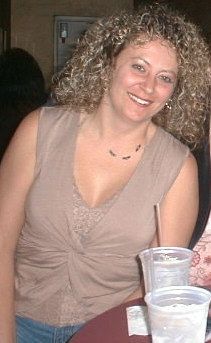Laura Kennedy Butler
age ~46
from Seattle, WA
- Also known as:
-
- Laura K Butler
- Laura R Butler
- Laura R Kennedy
- Laura Ruth Kennedy
- Laur A Butler
- Phone and address:
- 4601 Phinney Ave N APT 304, Seattle, WA 98103
Laura Butler Phones & Addresses
- 4601 Phinney Ave N APT 304, Seattle, WA 98103
- Asheboro, NC
- High Point, NC
- Springfield, MO
- 2111 Churchill Dr, Greensboro, NC 27410 • 336 291-0283
Work
-
Company:Wilde Sapte
-
Address:
Specialities
Buyer's Agent • Listing Agent
Us Patents
-
Application Sharing In A Frame
view source -
US Patent:6570590, May 27, 2003
-
Filed:Oct 6, 1999
-
Appl. No.:09/413451
-
Inventors:Deborah L. Dubrow - Kirkland WA
Laura J. Butler - Seattle WA
Jane L. Dailey - Seattle WA
Claus T. Giloi - Redmond WA -
Assignee:Microsoft Corporation - Redmond WA
-
International Classification:G09G 500
-
US Classification:345751, 345753, 345748
-
Abstract:User interface for displaying and interacting with images corresponding to applications shared over a computer network in a data conference is described. The described interface provides a user with greater control over the use of a desktop by providing controls for moving and sizing images, including fake windows, corresponding to shared applications by displaying such windows in a frame. The frame is the entity that is manipulated by a user with familiar graphical symbols, or even custom designs, thus avoiding potential complexity in managing control over the images of the shared applications. This user interface facilitates frames that may optionally be semi-transparent or transparent in order to allow a user to keep track of icons and windows covered by the frame. Frames are also useful in reducing network traffic by providing a method for detecting the level of interest of a user in a shared application. Thus, they can be used to modulate the frequency of updating images of shared applications to reflect the need for changes determined by whether the frame is in focus or even closed.
-
Repositioning And Displaying An Object In A Multiple Monitor Environment
view source -
US Patent:6573913, Jun 3, 2003
-
Filed:Jan 10, 2000
-
Appl. No.:09/480761
-
Inventors:Laura J. Butler - Seattle WA
Adam Smith - Redmond WA -
Assignee:Microsoft Corporation - Redmond WA
-
International Classification:G06F 314
-
US Classification:345761, 345764, 345778, 345562, 345 11, 345 13
-
Abstract:Systems and methods for repositioning and displaying objects in multiple monitor environments are disclosed. When two or more of the monitors have different color characteristics, images moved between monitors are processed to take advantage of the particular color characteristics of the monitors, while reducing the processing resources that might otherwise be needed to entirely render the image from scratch. For instance, an image positioned within a first monitor space can be repositioned such that a first portion is displayed in the first monitor space and a second portion in the second monitor space. The data representing the first portion of the image is moved from a first location to a second location in a frame buffer in a bit block transfer operation. If the first and second monitors have the same color characteristics, the data representing a second portion is also transferred using a bit block operation. However, if the color characteristics are different, the data representing the second portion of the image is passed through a display engine that adapts the data to the particular color characteristics of the second monitor.
-
Multiparty Conferencing And Collaboration System Utilizing A Per-Host Model Command, Control And Communication Structure
view source -
US Patent:6584493, Jun 24, 2003
-
Filed:Sep 14, 1999
-
Appl. No.:09/395508
-
Inventors:Laura J. Butler - Seattle WA
-
Assignee:Microsoft Corporation - Redmond WA
-
International Classification:G06F 1516
-
US Classification:709204, 709205, 709213, 709216
-
Abstract:A networking conferencing and collaboration tool utilizing an enhanced T. 128 application sharing protocol. This enhanced protocol is based on a per-host model command, control, and communication structure. This per-host model reduces network traffic, allows greater scalability through dynamic system resource allocation, allows a single host to establish and maintain a share session with no other members present, and supports true color graphics. The per-host model allows private communication between the host and a remote with periodic broadcasts of updates by the host to the entire share group. This per-host model also allows the host to allow, revoke, pause, and invite control of the shared applications. Subsequent passing of control is provided, also with the hosts acceptance. The model contains no fixed limit on the number of participants, and dynamically allocates resources when needed to share or control a shared application.
-
Scalable Multiparty Conferencing And Collaboration System And Method Of Dynamically Allocating System Resources And Providing True Color Support In Same
view source -
US Patent:7136062, Nov 14, 2006
-
Filed:Sep 14, 1999
-
Appl. No.:09/395480
-
Inventors:Laura J. Butler - Seattle WA, US
-
Assignee:Microsoft Corporation - Redmond WA
-
International Classification:G06T 15/40
-
US Classification:345422, 345597, 345591, 345600, 345605
-
Abstract:A networking conferencing and collaboration tool utilizing an enhanced T. 128 application sharing protocol. This enhanced protocol is based on a per-host model command, control, and communication structure. This per-host model reduces network traffic, allows greater scalability through dynamic system resource allocation, allows a single host to establish and maintain a share session with no other members present, and supports true color graphics. The per-host model allows private communication between the host and a remote with periodic broadcasts of updates by the host to the entire share group. This per-host model also allows the host to allow, revoke, pause, and invite control of the shared applications. Subsequent passing of control is provided, also with the hosts acceptance. The model contains no fixed limit on the number of participants, and dynamically allocates resources when needed to share or control a shared application.
-
Scalable Multiparty Conferencing And Collaboration System And Method Of Dynamically Allocating System Resources In Same
view source -
US Patent:7167182, Jan 23, 2007
-
Filed:Feb 23, 2004
-
Appl. No.:10/785163
-
Inventors:Laura J. Butler - Seattle WA, US
-
Assignee:Microsoft Corporation - Redmond WA
-
International Classification:G06F 13/00
-
US Classification:345537, 345538, 345543, 345544, 715751, 715749, 715753, 709213, 709215, 709212, 709208, 709201
-
Abstract:A networking conferencing and collaboration tool utilizing an enhanced T. 128 application sharing protocol. This enhanced protocol is based on a per-host model command, control, and communication structure. This per-host model reduces network traffic, allows greater scalability through dynamic system resource allocation, allows a single host to establish and maintain a share session with no other members present. The per-host model allows private communication between the host and a remote with periodic broadcasts of updates by the host to the entire share group. This per-host model also allows the host to allow, revoke, pause, and invite control of the shared applications. Subsequent passing of control is provided, also with the hosts acceptance. The model contains no fixed limit on the number of participants, and dynamically allocates resources when needed to share or control a shared application. These resources are then freed when no longer needed.
-
Method And System For The Authoring And Playback Of Independent, Synchronized Media Through The Use Of A Relative Virtual Time Code
view source -
US Patent:7913157, Mar 22, 2011
-
Filed:Apr 17, 2007
-
Appl. No.:11/736352
-
Inventors:Richard Wales Stoakley - Seattle WA, US
Laura Janet Butler - Seattle WA, US -
Assignee:Overcast Media Incorporated - Seattle WA
-
International Classification:G06F 17/00
-
US Classification:715203, 715201, 715202, 715204, 715723, 725135, 725136, 386 12, 386 61, 386 65, 386 66
-
Abstract:A method and system is provided for the creation and playback of multiple independently produced and distributed media intended for synchronized playback. One embodiment of the invention overcomes variances in independently produced and distributed media that make accurate synchronization impossible today. The system utilizes both authoring and playback processes. During authoring, a relative virtual time code profile is generated based on the original source media in a defined associated media set. The system employs an extensible framework of multiple synchronization recognizers that analyze the source media to generate a relative virtual time code profile for the associated media set. During playback, the system's client can access the relative virtual time code profile to coordinate the synchronized playback of an associated media set. The system generates an absolute time code using the available associated media and the original relative virtual time code profile. The system can overcome significant variances between the available associated media and the original associated media such as missing content, added content, resolution differences, format differences, etc.
-
Providing Enhanced Content With Broadcast Video
view source -
US Patent:20020007493, Jan 17, 2002
-
Filed:Jul 29, 1997
-
Appl. No.:08/902005
-
Inventors:LAURA J. BUTLER - SEATTLE WA, US
GEORGE M. MOORE - REDMOND WA, US -
International Classification:H04N007/173
H04N005/445 -
US Classification:725/109000, 725/110000, 725/037000
-
Abstract:A video broadcast system includes a broadcast source that broadcasts a video stream and provides accompanying supplemental data files. Each supplemental data file is an HTML file having instructions for rendering a hyperlink overlay on the video stream. A receiver is configured to receive the video stream and accompanying supplemental data files and to display the hyperlink overlays in conjunction with the video stream. The overlays are designed having backgrounds of a pre-determined value which is used as a color key in receiving equipment. Specifically, the receiving equipment is configured to render video only in display areas that are set to the color key value. Thus, the video stream is rendered “behind” the hyperlink overlays, and the backgrounds of the overlays appears transparent. Control data is provided with the HTML files to indicate when the overlays should be rendered and to provide other instructions on how the HTML files should be handled by the receiving equipment.
-
Method And System For Scalable Borders That Provide An Appearance Of Depth
view source -
US Patent:55902677, Dec 31, 1996
-
Filed:Jun 5, 1995
-
Appl. No.:8/462523
-
Inventors:Laura J. Butler - Bellevue WA
Joyce A. Grauman - Seattle WA -
Assignee:Microsoft Corporation - Redmond WA
-
International Classification:G09G 300
-
US Classification:395340
-
Abstract:Scalable three-dimensional borders are provided in the user interface of an operating system. The borders are scalable in several respects. First, the dimensions of the borders are scalable relative to the resolution of a video display upon which the borders will be drawn. Second, the colors used in the borders are scalable based upon the range of luminances available on the video display. The borders are colored to provide the visual illusion of depth such that the borders appear to be three-dimensional.
Lawyers & Attorneys
License Records
Laura Butler
License #:
15456 - Active
Issued Date:
Sep 30, 1994
Renew Date:
Dec 1, 2015
Expiration Date:
Nov 30, 2017
Type:
Certified Public Accountant
Laura Grace Butler
Phone:
972 840-0869
License #:
1132389 - Expired
Category:
Cosmetology Operator
Expiration Date:
Jul 8, 2016
Laura F Butler
License #:
2220894 - Expired
Issued Date:
Aug 10, 1993
Expiration Date:
Nov 30, 1996
Type:
Cosmetologist Type 2
Laura Ellen Butler
License #:
53089 - Expired
Category:
Nursing Support
Issued Date:
Oct 8, 2004
Effective Date:
Apr 29, 2009
Expiration Date:
Oct 8, 2007
Type:
Medication Aide
Laura Ellen Butler
License #:
67745 - Active
Category:
Nursing Support
Issued Date:
May 25, 2011
Effective Date:
May 25, 2011
Expiration Date:
May 25, 2017
Type:
Medication Aide - 40 Hour
Name / Title
Company / Classification
Phones & Addresses
President
Das, Inc
Billing and Bookkeeping Service
Billing and Bookkeeping Service
611 Main St, Edmonds, WA 98020
Isbn (Books And Publications)
-
Writing On The Wind: An Anthology Of West Texas Women Writers
view source -
Author:Laura Payne Butler
-
ISBN #:0896725405
-
Writing On The Wind: An Anthology Of West Texas Women Writers
view source -
Author:Laura Payne Butler
-
ISBN #:0896725480
Classmates

Laura Murray (Butler)
view sourceSchools:
Marcellus High School Marcellus NY 1970-1974
Community:
Stanley Latz, Mary Cook
Biography:
After graduatio I attended Auburn CC and went to work for an Insurance Co. In 1976 ...

Laura Taylor (Butler)
view sourceSchools:
Moselle Elementary School Moselle MS 1967-1971
Community:
Mary Talbutt, Charles Chambliss, Danny Murphy, Lisa Brock

Laura Harney (Butler)
view sourceSchools:
Goshen Elementary School Goshen AL 1979-1983, Goshen High School Goshen AL 1982-1984, Eustis Middle School Eustis FL 1984-1985
Community:
Tanya Worsham, Tasha Bundy, Lindon Rivers, Donna Johnson, Kathryn Love

Laura Mann (Butler)
view sourceSchools:
Vanwig Elementary School La Puente CA 1986-1993, Quail Valley Middle School Phelan CA 1995-1996
Community:
John Surratt, Alicia Smith
Biography:
Life
well life has been good for me, i started a new job at maranatha correctional ...

Laura Haley (Butler)
view sourceSchools:
Boulder City Elementary School Boulder City NV 1975-1976
Community:
Dennis Brough, Cricket Lopuch
Biography:
Well I live in Spokane, WA with my husband (Anthony) of 10 years. But we have been t...

Laura Hanford (Butler)
view sourceSchools:
Oakwood High School Marietta GA 1982-1986, Addison Elementary School Marietta GA 1984-1987
Community:
Haden Davis
Biography:
I now live in the Charleston area now
With my husband and two children.
I now have a...

Laura Butler (Coats)
view sourceSchools:
Saints Junior College & Academy Lexington MS 1970-1974
Community:
Kevin Neal, Letha Barron, Cherita Braud, Michael Lawrence

Laura Mauldin (Butler)
view sourceSchools:
Saints Junior College & Academy Lexington MS 1968-1972
Community:
Kevin Neal, Letha Barron, Cherita Braud, Michael Lawrence
Flickr
Googleplus

Laura Butler
Work:
Draughting Solutions - Accounts Assistant (2012)
Pizza Hut - Waitress (2009-2012)
Pizza Hut - Waitress (2009-2012)
Education:
Maidstone Grammar School for Girls

Laura Butler
Education:
West rowan high
Bragging Rights:
I'm a singer, I have a great boyfriend, and I;m going to be an RN one day.

Laura Butler
Work:
Ariel Corporation - Production Planner (2007)

Laura Butler
Education:
Northeastern State University

Laura Butler
Work:
Charming~* - Jewellery Designer

Laura Butler
Tagline:
Im Cool!!!

Laura Butler
About:
I'm Laura. I'm 2x years old and I study English (that means that I'm learning english so probably I'll have a lot of mistakes specially Grammar ones) I'm from Argentina. Every free...

Laura Butler
About:
Http://www.urbandictionary.com...
Tagline:
I am a capsule of energy
Plaxo

Laura Butler
view sourceBrightonConsultant at Stelfox Past: Research Analyst at American Express

Laura A. Butler
view sourceResearch Editor/Contributing Writer at Back Stage Past: Film Research Editor at Baseline Studio System
Myspace

Laura Butler Keiser
view source
Laura Butler
view source
Laura Butler Davis
view source
Laura Butler Wright
view source
Laura Butler
view source
Laura Butler Geesaman
view source
Laura Stauffer Butler
view source
Laura Butler Cruz
view sourceYoutube
Get Report for Laura Kennedy Butler from Seattle, WA, age ~46

















